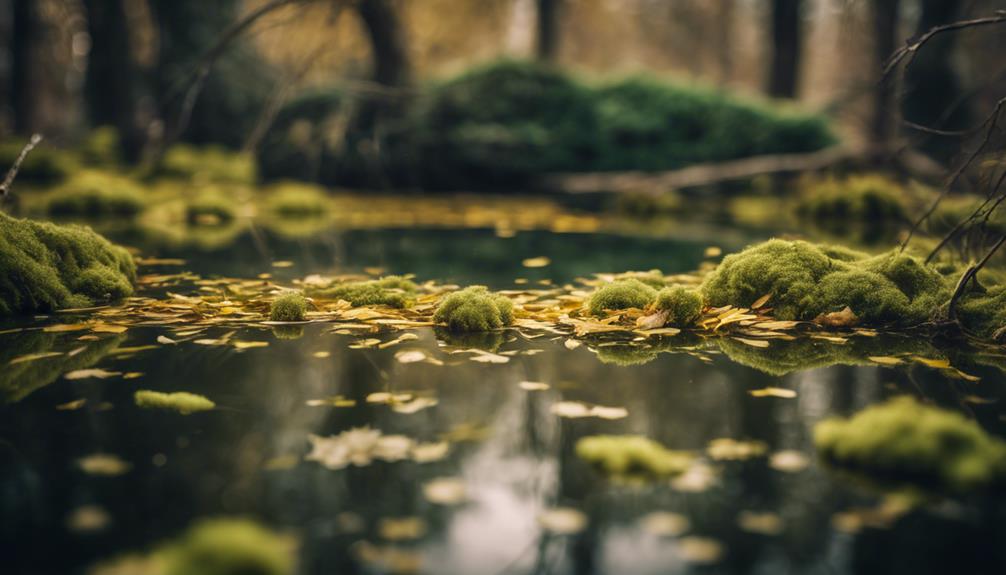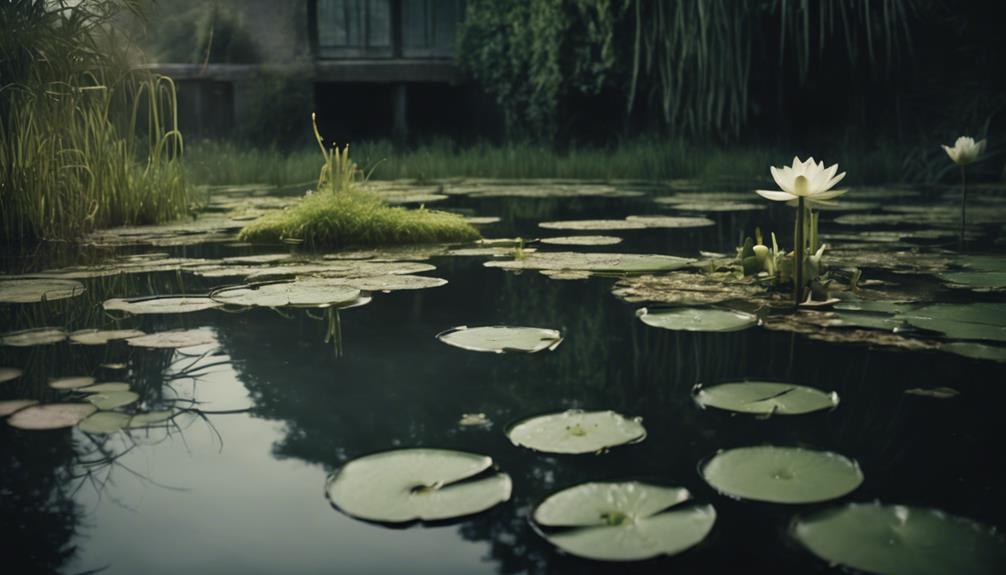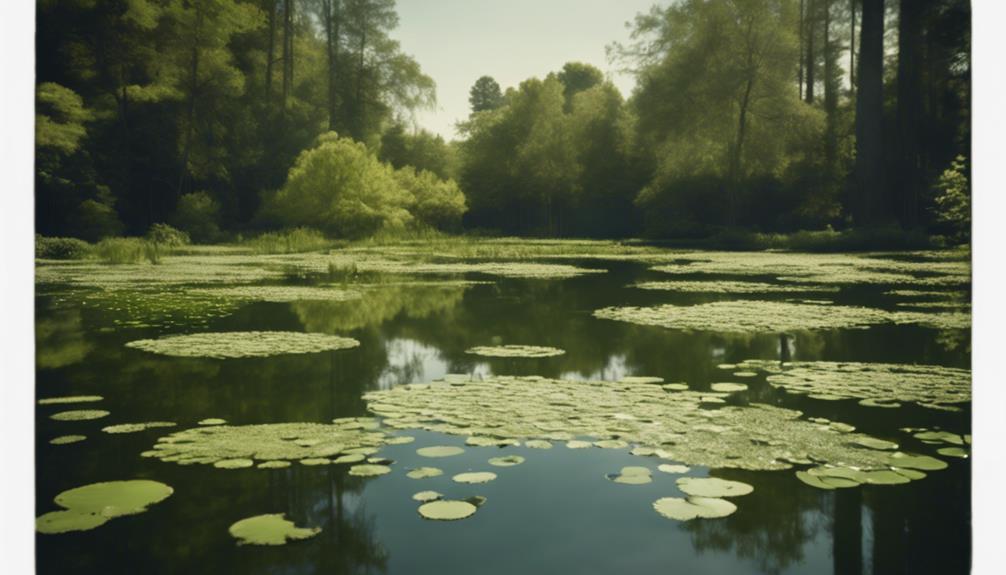You're not alone in wondering why algae grows in your small pond. It's a natural process, but one that can get out of hand quickly. Algae thrive in water with ideal temperatures, excessive nutrients like phosphorus and nitrogen, and slightly alkaline pH levels. When these factors combine, algae growth can explode, leading to murky green water and toxic blooms. You've probably introduced these factors unintentionally through stormwater runoff, fertilizers, or an imbalance in aquatic life. Now that you know the basics, understanding how to prevent and control algae growth in your small pond is just a step away.
Table of Contents
Key Takeaways
- Algae grows in small ponds due to excess nutrients, particularly phosphorus and nitrogen, which fuel its growth and lead to blooms.
- Ideal temperatures between 65°F and 85°F create a conducive environment for algae growth in small ponds.
- A slightly alkaline pH level between 7 and 9 favors algae growth, making small ponds with such conditions more prone to algae blooms.
- Imbalance in aquatic life and lack of natural predators in small ponds can disrupt the food chain, allowing algae to dominate.
- Stormwater runoff and fertilizers from surrounding areas can introduce excess nutrients into small ponds, triggering algae growth.
Understanding Algae Basics
Understanding is vital to recognize that the term 'algae' encompasses a broad range of aquatic, plant-like organisms that lack true root systems and are capable of photosynthesis.
As a pond owner, mastering the basics of algae growth is paramount to effectively control it.
Algae can be classified into four main types: blue-green, planktonic, filamentous, and chara. Planktonic algae, for instance, are microscopic and suspended in the water column, while filamentous algae form mats or strings.
Excess nutrients, particularly phosphorus and nitrogen, fuel algae growth, leading to blooms that can produce toxins harmful to aquatic life.
A small amount of algae is a natural and harmless part of a healthy ecosystem, but excessive growth can degrade water quality.
Major Factors for Algae Growth
What triggers the explosive growth of algae in small ponds, and what're the key factors that contribute to its proliferation?
As a pond owner, you're likely wondering why your once-pristine waterbody has turned into a green soup. The answer lies in the perfect storm of conditions that favor algae growth.
Algae are microscopic organisms that thrive in pond water with ideal temperatures between 65°F and 85°F. When water temperatures rise, algae growth accelerates.
Additionally, excessive levels of phosphorus and nitrogen in the water, often introduced through stormwater runoff, fertilize algae growth. These nutrients can come from nearby agricultural activities, sewage, or even your own lawn care practices.
The water's pH level also plays a vital role. Algae growth is favored when the pH is slightly alkaline, between 7 and 9.
Moreover, an imbalance in aquatic life can disrupt the natural food chain, allowing algae to dominate. When these factors combine, you get the perfect recipe for excessive algae growth.
Consequences of Algae Blooms

When algae blooms proliferate in your small pond, they can trigger a cascade of devastating consequences that threaten the health of your aquatic ecosystem and even human well-being.
You'll notice your pond water turning murky green, a clear sign of algae problems. This green water not only looks uninviting but also harbors toxic substances produced by blue-green algae that can kill fish and other aquatic life by blocking sunlight and clogging their gills.
As algal blooms grow, they deplete oxygen levels in the water column, creating 'dead zones' where aquatic life can't survive. What's more, these harmful algal blooms can contaminate your drinking water sources and even affect individuals with respiratory conditions.
Climate change has contributed to the alarming 18% increase in algal blooms between 2018 and 2019, making it a pressing concern for pond owners like you.
Crucial to take proactive measures to prevent these algae problems from spiraling out of control.
Prevention and Control Methods
To regain control of your small pond's ecosystem, you can implement several prevention and control methods to combat algae growth and mitigate its devastating consequences.
Implement aeration devices to increase oxygen levels and water circulation, reducing planktonic algae growth during the summer.
Maintain your septic systems properly and redirect nutrient-rich runoff away from the pond to limit excess nutrient input, thereby preventing algae growth.
Use beneficial bacteria, enzyme, or herbicide products to control algae growth, but make sure to obtain a state permit and exercise caution to avoid harming aquatic life.
Provide shade on the pond's surface to reduce sunlight exposure, which can contribute to algae blooms, and regularly clean the pond to remove excess plant growth and nutrients from the water.
Essential Pond Maintenance Tips

You can maintain a healthy balance in your small pond's ecosystem by following a few essential maintenance tips that focus on preventative measures and regular upkeep.
Regular pond cleaning is vital, as it removes excess plant growth and composts it, thereby reducing nutrients that fuel algae growth.
Additionally, incorporating aquatic plants that compete with algae for light and nutrients can help keep algae under control. Faster-growing plants are more effective at suppressing algae growth.
It's also important to avoid overfeeding your fish, as excess nutrients can lead to string algae growth.
Provide shade on the pond's surface by adding marginal pond plants to diminish the possibility of green water and reduce algae growth.
Finally, perform regular water changes to maintain water quality and monitor your pond for signs of algae growth.
Managing Algae in Small Ponds
By understanding the factors that contribute to algae growth, you can implement targeted strategies to manage and control it in your small pond. Algae growth is often a result of excess nutrients in the water, which can lead to unsightly blooms and negatively impact the overall health of your pond.
To take control of algae growth, consider the following strategies:
- Reduce or redirect obvious sources of nutrients to prevent excess nutrients from entering the water.
- Install aeration devices to increase oxygen levels and water circulation, making it harder for algae to thrive.
- Use bacteria, enzyme, or herbicide products to control algae growth, but be sure to obtain the necessary state permit and exercise caution to avoid harming aquatic life.
- Maintain vegetative buffer strips around the pond to absorb excess nutrients and prevent runoff.
Frequently Asked Questions
What Causes Algae in Small Ponds?
You identify the causes of algae in small ponds by examining water quality, nutrient levels, sunlight exposure, pond depth, and water circulation, as well as considering algae types, environmental factors, and climate changes that impact growth.
How Do I Keep Algae Out of My Small Pond?
As you gaze into your serene pond, imagine a balanced ecosystem where you, the guardian, maintain harmony by implementing pond aeration, regular cleaning, and introducing algae eaters, beneficial bacteria, and UV clarifiers to keep algae at bay.
What Causes Excessive Algae Growth?
You uncover the root causes of excessive algae growth by examining factors like water pollution, nutrient overload, pH imbalance, temperature fluctuations, light intensity, carbon dioxide levels, oxygen depletion, and microorganism activity that disrupt your pond's delicate ecosystem.
Will Algae Go Away on Its Own in a Pond?
"You'll be thrilled to know that, without intervention, algae will eventually decrease on its own in your pond due to seasonal fluctuations, but don't hold your breath – stagnant water, high nutrient levels, and oxygen depletion can prolong the issue."
Conclusion
As you gaze out at your small pond, now teeming with life, you might wonder: will it ever be possible to banish algae for good?
Probably not, but by grasping the basics of algae growth, addressing the major factors that fuel its spread, and implementing prevention and control methods, you can maintain a healthy balance.
With regular maintenance and careful management, your pond can thrive, its waters clear and inviting.
Can you imagine the serenity of a pond where fish swim freely, unencumbered by the murky veil of algae?

